Operating in one of the most hotly-contested segments in the Aussie new car market, the Hyundai Tucson goes up against more than a dozen major mid-size SUV players, the heavyweights being Mazda’s evergreen CX-5, Mitsubishi’s brand-spanking new fourth-gen Outlander, Nissan’s soon to be renewed X-Trail, Subaru’s ever-popular Forester, and Toyota’s category-leading elephant in the room, the RAV4.
The era of automotive electrification continues to progress, but turbo-diesel power remains popular with buyers in this class. So we decided to take a look at this family favourite in diesel guise only.
Hyundai Tucson 2022: (FWD)
| Engine Type | Inline 4, 2.0L |
|---|---|
| Fuel Type | Unleaded Petrol |
| Fuel Efficiency | 8.1L/100km (combined) |
| Seating | 5 |
| Price From | $26,290 - $32,450 |
| Safety Rating |
|
Does it represent good value for the price? What features does it come with?
7 / 10
The entry-point to the three-model Tucson range is only available with a 2.0-litre, four-cylinder petrol engine, so here we’ll concentrate on the mid-grade Elite diesel ($45,000, before on-road costs) and the top-tier Highlander diesel ($52,000 BOC). Both are available with a sporty N Line option pack adding $2000 and $1000, respectively to the price tag.
To keep up with the medium SUV Joneses, and satisfy buyers spending ‘around’ $50K on a set of wheels, the Tucson needs a lengthy features list, on top of the safety and performance tech covered later in this review.
Included in the Elite are, keyless entry and start (including remote start), sat nav (with live traffic updates), a 10.25-inch multimedia touchscreen, six-speaker audio (including corded Apple CarPlay/Android Auto compatibility and digital radio), leather-appointed seats, gearshift and steering wheel, a 10-way power-adjustable driver’s seat, heated front seats, rear privacy glass, heated and auto-folding exterior mirrors, 18-inch alloy wheels, auto rain-sensing wipers, a 4.2-inch digital screen in the instrument cluster, and dual-zone climate control.

Tick the box for an N Line version of the Elite and you’ll pick up LED headlights, DRLs, and (black-tinted) tail-lights, 19-inch rims, high-beam assist, suede and leather-appointed seats, black cloth headlining, plus a super-slick configurable 10.25-inch instrument screen, and N Line cosmetic tweaks.
Step up to the Highlander and on top of the Elite’s spec you can add, eight-speaker Bose premium audio, eight-way power adjustment for the front passenger seat (as well as slide and recline adjustment accessible to the driver), ventilated front seats, heated rear seats, a heated steering wheel, a panoramic glass sunroof (with power sunblind), a power tailgate, an electro-chrimatic interior mirror, and ambient lighting.
On the Highlander the N Line pack is 50 per cent cheaper because things like 19-inch alloys and the trick digital instrument display are already included.
That’s a class-competitive, but not quite class-leading spec. For example the top-shelf RAV4 Edge is several thousand dollars cheaper than the Tucson Higlander, and capital L Loaded.
Is there anything interesting about its design?
8 / 10
Although the Tucson’s silhouette follows a clearly recognisable mid-size SUV template the design details within it are distinctively different.
A multi-faceted grille blends with sectional, angular headlight clusters either side, and sits above the swoopy curved top of a secondary air-intake underneath. There’s nothing else remotely like it in the segment, or the market more broadly for that matter.
The car’s flanks are segmented by distinct creases running at an angle through the front and rear doors, accentuating the way they’re drawn inwards along their lower edges.

Our Elite grade test car’s 18-inch alloy rims are ‘busy’ in the style of a frenetic Cubist painting, and the geometric theme continues at the back with jagged tail-lights adding visual interest to an otherwise conventional rear end treatment.
Available colours are on the 'muted' side: 'Titan Grey', 'Deep Sea' (blue), 'Phantom Black', 'Shimmering Silver', 'Amazon Gray', and 'White Cream.'
Inside the look is clean and simple with a two-tier dash top flowing in towards the large, central multimedia screen and ventilation control panel. A pair of chrome ‘rails’ define the upper level, also housing the air vents as they curve around and continue into the front doors.
The interior palette is predominantly grey with gloss black and brushed metal accents, while the leather-appointed seats are fuss-free with detail metal highlights contributing to an overall relaxed, quality feel.

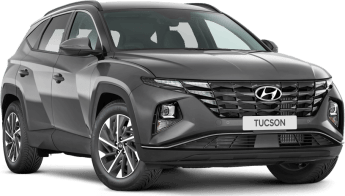
How practical is the space inside?
9 / 10
At just over 4.6m long, a little under 1.9m wide, and close to 1.7m high, the Tucson sits squarely inside the mid-size SUV class footprint.
Space efficiency in the front is impressive with the simple dash design and forward-sloping centre stack adding to a feeling of openness. There’s ample headroom for my 183cm frame and storage is plentiful.
There’s a pair of cupholders in the centre console, a tray incorporating a Qi wireless charging pad ahead of the transmission shift buttons, a bin/armrest between the seats, large pockets in the doors with space for bottles, and a decent glove box.

Move to the rear and legroom is impressive. Sitting behind the driver’s seat set for my position I enjoyed heaps of headroom and there’s enough shoulder room to make three adults across the back seat comfortably do-able for up to medium-length journeys.
Inclusion of twin adjustable air vents is a plus, and storage runs to a pair of cupholders in the fold-down centre armrest, deep bottle holders in the doors, and map pockets on the backs of the front seats.
Power and connectivity options include two USB-A sockets in the front (one multimedia, one charging only), plus another two (charge-only) in the rear. There’s a 12-volt outlet in the front console and another in the boot.

Speaking of which, the critical boot space measurement is a useful 539 litres (VDA) with the rear seat upright, and no less than 1860L with the 60/40 split-folding backrest down.
Remote release handles for the rear seat on either side of the cargo area are a thoughtful addition.
We were able to fit the CarsGuide three-piece suitcase set and a bulky folding pram in with room to spare. Tie down anchors and bag hooks are included and a full-size alloy spare sits under the boot floor. Nice.
If towing’s on your priority list the Tucson diesel is rated at 1900kg for a braked trailer and 750kg unbraked, plus ‘Trailer Stability Assist’ is standard.
What are the key stats for the engine and transmission?
8 / 10
Tucson diesel models are powered by a 2.0-litre, four-cylinder, common-rail direct-injection turbo engine. The all-alloy (D4HD) design is part of Hyundai’s ‘Smartstream’ engine family, producing 137kW at 4000rpm, and 416Nm from 2000-2750rpm.
An eight-speed (traditional torque-converter) automatic transmission feeds power to Hyundai’s ‘HTRAC’ on-demand all-wheel drive system, a multi-mode set-up built around an electronic, variable torque-split clutch (using inputs like vehicle speed and road conditions) to manage distribution of drive between the front and rear axles.

How much fuel does it consume?
8 / 10
Hyundai’s official fuel economy figure for the Tucson diesel, on the ADR 81/02 - urban, extra-urban cycle, is 6.3L/100km, the 2.0-litre four emitting 163g/km of C02 in the process.
Over a mix of city, suburban, and freeway driving we saw a real-world (at the bowser) average of 8.0L/100km, which is pretty handy for a car of this size and weight (1680kg).
You’ll need 54 litres of diesel to fill the tank, which translates to a range of 857km using Hyundai’s official economy number, and 675km based on our ‘as tested’ figure.
Warranty & Safety Rating
What safety equipment is fitted? What safety rating?
8 / 10
Time to strap in (literally) because Hyundai gives safety a solid crack in the current Tucson. Although the car hasn’t been assessed by ANCAP or Euro NCAP, it is loaded with active and passive tech, and would surely score a maximum five-star result.
Designed to help you avoid an impact, Hyundai’s ‘SmartSense’ active safety package includes, lane keeping assist and ‘Forward Collision-Avoidance Assist’ (Hyundai-speak for AEB) including vehcile, pedestrian, and cyclist detection, with a ‘Junction Turning’ function.
In detecting cars the system issues a warning between 10-180km/h and applies full braking between 10-85km/h. For pedestrians and cyclists the thresholds are 10-85km/h and 10-65km/h, respectively.
But the list goes on with ‘Intelligent Speed Limit Assist’, ‘Driver Attention Warning’, adaptive cruise control (with stop and go), a rear view camera (with dynamic guidelines) rear cross-traffic alert, and a tyre pressure monitoring system.
Front and rear parking distance warning is standard on all diesel Tucsons.
Some features like a ‘Remote Smart Parking Assist’, ‘Surround View Monitor’ and blind-spot monitoring are only included on the top-shelf Highlander (diesel) grade.
But if an impact is unavoidable there are seven airbags on-board (front, front side (thorax), curtain and front centre side).
There are three shield restraint top tether points across the back seat with ISOFIX anchors on the two outer positions.
What does it cost to own? What warranty is offered?
8 / 10
Hyundai covers the Tucson with a five year/unlimited km warranty, and the ‘iCare’ program includes a ‘Lifetime Service Plan’, as well as 12 months 24/7 roadside assist and an annual sat nav map update (the latter two renewed free-of-charge each year, up to 10 years, if the car is serviced at an authorised Hyundai dealer).
Maintenance is scheduled every 12-months/15,000km (whichever comes first) and there’s also a pre-paid option which means you can lock in prices and/or fold service costs into your finance package.

The first service is free (recommended at one month/1500km), and Hyundai Australia’s website allows owners to price maintenance costs out to 34 years/510,000km.
Over a slightly shorter timeframe a service for the Tucson diesel will currently set you back $375 for each of the first five years, which is in the middle ground for the segment.
What's it like to drive?
7 / 10
Maximum power of 137kW in a roughly 1.7-tonne SUV may not seem like a tarmac-tearing equation, but it’s the Tucson diesel’s hefty torque output that puts life into this machine.
Peak pulling power of 416Nm is available from 2000-2750rpm and this five-seater gets up and goes. You can expect 0-100km/h acceleration in the high 9.0sec bracket and mid-range punch makes the Tucson diesel an effortless proposition around the city and suburbs. Eight ratios in the auto means freeway cruising is relaxed, too.
The downside of diesel is invariably engine noise, and although the Tucson’s 2.0-litre unit rarely lets you forget it’s there it’s not a massive deal.

While the auto is smooth and geared nicely, I’m not a fan of the electronic ‘shift-by-wire’ selector buttons on the console.
Yes, it saves space, and yes, Ferrari does it, but there’s something about the ability to simply move or flick a more conventional shifter that makes parking or three-point turning maneuvers smoother and less intense than pushing individual buttons.
The suspension set-up is strut front, multi-link rear, and unlike the majority of Hyundais released here in recent years this car’s tune is ‘global’ rather than one developed in local conditions.

On smooth surfaces the ride is supple enough, but typically patchy suburban roads make their presence felt. That said, the car feels stable and under control in corners, although the steering feels overly light, and road feel is okay only. .
We stuck to the bitumen for this test, but those keen on light off-highway work will have Hyundai’s ‘Multi-terrain’ system at their disposal, with ‘Snow’, ‘Mud’, and ‘Sand’ settings offered.
All around vision is good, the seats remain comfortable and supportive over longer distances, and the brakes (305mm vented discs front / 300mm solid discs rear) are nice and progressive.
The big multimedia screen looks sleek and presents well in terms of navigation, although I’d be in favour of physical dials for major controls like audio volume. But you may feel differently.
Verdict
Well packaged and ultra-practical with strong performance, the Hyundai Tucson diesel has a lot going for it. Add excellent safety, solid economy plus a good ownership package, and it’s looking even better. The value equation could be sharper, driving refinement more polished and some may need time to acclimatise to its distinctive design. But the Tucson diesel is a quality mid-size SUV option.
Pricing Guides





























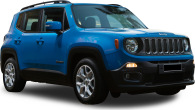









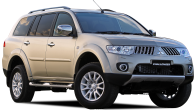




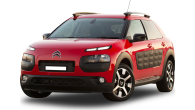




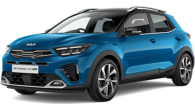



.jpg)
_0.jpg)



